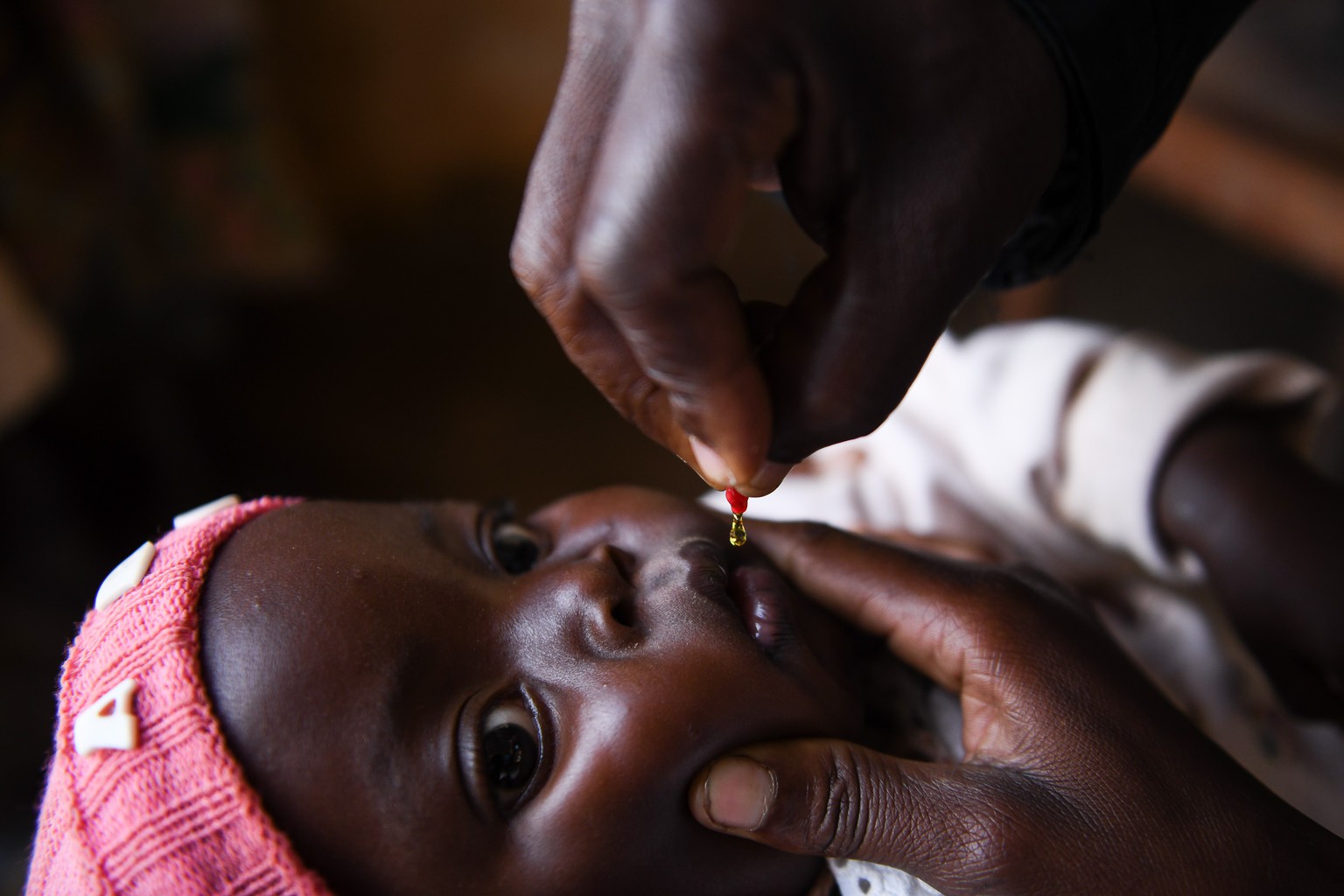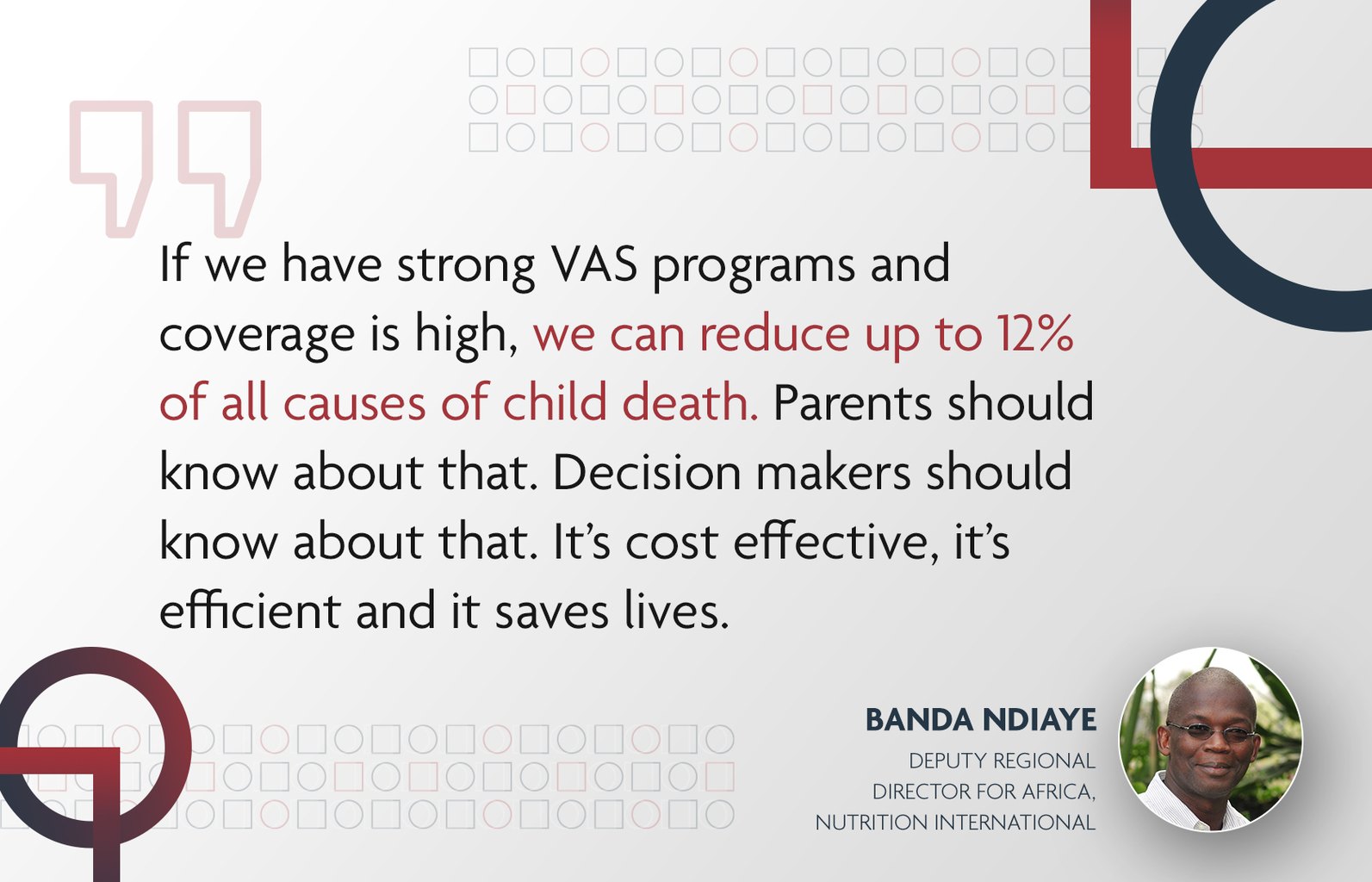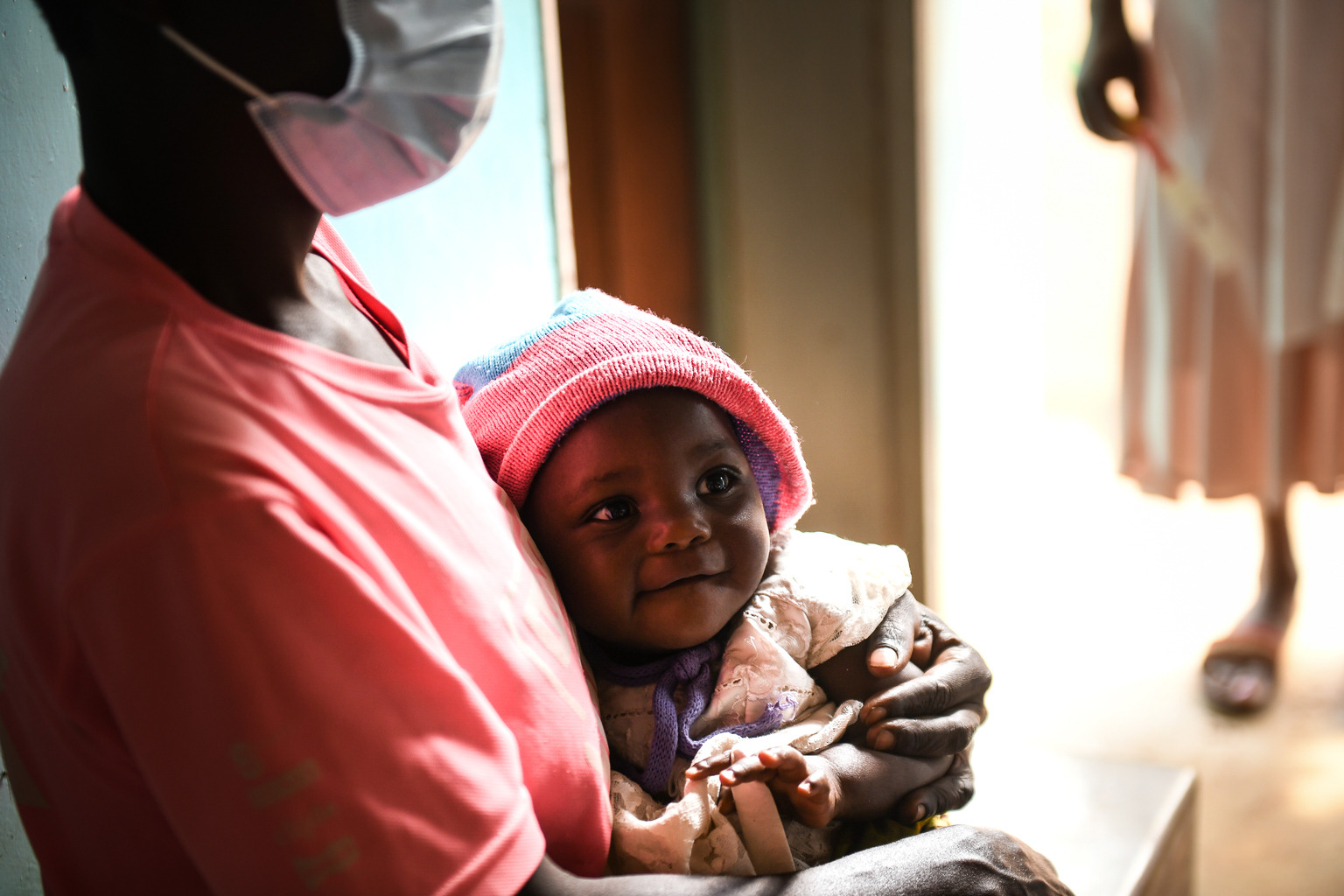Field Stories
Follow the vitamin A to an island in Bangladesh
March 12, 2025
WP_Term Object
(
[term_id] => 49
[name] => Field Stories
[slug] => all-field-stories
[term_group] => 0
[term_taxonomy_id] => 49
[taxonomy] => news-category
[description] => Discover the personal stories of people whose lives have been impacted by better nutrition, and those working tirelessly to deliver it.
[parent] => 0
[count] => 180
[filter] => raw
)
Insight from the frontlines: why is a vitamin A catch-up initiative needed now?
In this Q&A, Nutrition International’s Deputy Regional Director for Africa shares his experience with vitamin A supplementation and why it needs to be a priority during the pandemic.
Posted on August 30, 2021
A mother waits for her baby to receive vitamin A at Luwanje Health Post in Mulanje, Malawi on 23 June 2021
Banda Ndiaye, Deputy Regional Director for Africa with Nutrition International, has over twenty years of experience implementing vitamin A supplementation (VAS) programming. In the late 1990s, when VAS was ramping up in countries across Africa, Ndiaye was the manager of a micronutrient and health project that included the first iterations of incorporating this essential micronutrient. “Since then, I’ve always worked in vitamin A supplementation programs and it’s part of my passion for nutrition intervention activities,” Ndiaye shared.
Since joining Nutrition International in 2006, he has remained a steadfast advocate and thoughtful leader in coordinating nutrition efforts to not only provide direct interventions, but simultaneously strengthen and reinforce health systems to better meet the needs of specific country contexts.
The impact of COVID-19 caused more than 100 million children around the world to miss at least one dose of vitamin A in 2020. In response, Nutrition International launched the “Saving Lives Through Vitamin A” initiative, funded by the Government of Canada, to reach children with this lifesaving intervention in countries with high levels of vitamin A deficiency.
We spoke with Ndiaye to get his perspective on why this initiative is needed now, what he wishes more people understood about VAS, and gain insight into what continues to motivate him.
Why is the vitamin A emergency catch-up initiative needed?
For several reasons. First of all, we know that essential services, including nutrition services and VAS, were negatively impacted by COVID-19. We know that many families, because they feared contamination or infection, didn’t want to go to health facilities. We also know that because of cost and reduced movement, not as many health workers were going out to communities. This resulted in the fact that in 2020 there were many countries where VAS campaigns were not organized as initially planned. In countries doing VAS through routine primary healthcare delivery services, attendance at the health facilities was affected. All those things put together clearly indicated the need and how pertinent it was to have this catch-up project.
In this project, we are working in countries across sub-Saharan Africa, as we know the need is great. The goal is to help countries catch up on VAS coverage that was declining even before COVID-19. That decline has been further aggravated by the pandemic. Our approach is to work closely with governments and partners to identify gaps in technical and financial support because every child has the right to survive and thrive. We were first thinking that our support would be needed in particularly vulnerable or fragile countries but over the last few months of implementation, it is clear the need for support, both technical and financial, is greater than we originally thought. We are currently in discussions with 18 countries to provide support this year. It gives you a sense of how pertinent and relevant this project is.

To take one step back, and look at the wider picture within which we are supporting country governments to deliver this catch-up project, why is VAS still a global health intervention that is needed in places around the world?
Why do we still need VAS? We should remind people that we are not doing VAS for the purpose of addressing vitamin A deficiency, but for the purpose of addressing the impact and consequences of vitamin A deficiency on child morbidity and mortality especially.
Child mortality is still very high in most sub-Saharan Africa countries. Vitamin A deficiency is still a public health problem in many of these countries as well. You will see that food fortification is still very weak in most of sub-Saharan Africa. The availability and consumption of vitamin A-rich food is also still very low. All this put together is justifying why we still need to have VAS programs in place.
When people who don’t work in global development hear that an organization provides a specific intervention like vitamin A, they might assume that means showing up, distributing the doses, and then leaving once those doses are given out. Can you speak to Nutrition International’s approach in providing vitamin A?
Our approach is integration. Talking about VAS, we want to make sure that this service is not just provided to children, but that the program support we provide to countries strengthens their health systems – that it sets an enabling environment and reinforces the capacities of the service delivery systems at the community and at the health facility levels – to provide children with the comprehensive nutrition services that they are supposed to get for their survival and development.

For example, in a country with weak growth monitoring and promotion (GMP) services, our support for implementing VAS will also include the provision of technical guidance and support for strengthening the GMP that will be used as part of the same platform where VAS will be delivered. The same applies for many other essential health and nutrition services, like screenings of acute malnutrition or community-based household visits. In this way, we are not just providing VAS, but we are also improving upon and strengthening an existing platform on which the VAS program can run. We also contribute to strengthening the community-based delivery system through the training, supervision and equipment of community healthcare providers that are motivated and contribute to the provision of essential primary healthcare services.
An integrated approach and opportunistic planning are essential and can make a program very effective.
What is something you wish more people knew or understood about VAS?
First, people should know that it’s one of the most cost-effective child survival interventions. The capsules themselves cost only about US $0.03 each. Second, people should know, especially governments, that it gives them the opportunity to strengthen their platforms for other nutrition services.
If we have strong VAS programs and coverage is high, we can reduce up to 12% of all causes of child death. Parents should know about that. Decision makers should know about that. It’s cost effective, it’s efficient and it saves lives.

Over the course of your career, why is vitamin A something that you’ve remained committed to and passionate about?
I am passionate about nutrition in general. My passion for nutrition and vitamin A started when I began to work in public health domains. I like taking action that can lead to tangible changes. I like going to the field and interacting with communities because it’s always a learning opportunity.
One day I was in the south of Senegal in a village. I was discussing with people, and while I was discussing, I was looking at a pregnant woman and without doing an assessment, simply by looking at her, you could see that she and the children her around were malnourished. It was obvious. There were clinical signs of malnutrition in this population. And I was thinking why is the government building a fancy hospital in Dakar, training obstetricians in Kolda to do cesarean, when this pregnant woman may have a likelihood to die from anaemia, for example, before reaching the hospital if she needs a cesarean?
I think that the priority is to first make sure that those populations have a strong nutritional status. I am convinced of this by the current COVID situation. Children or adults who have a better nutritional status, including vitamin A, are more likely to have stronger immune systems that can help them survive and cope with the COVID-19 infection. I am passionate about vitamin A because of its ability to save lives. It’s a few drops of vitamin that you provide to a child every four to six months that can save their life. It’s important especially in sub-Saharan Africa. And I really think nothing is more important for a parent than seeing his or her child surviving. I am sure that if a parent knew the impact VAS could have on their child’s health status and survival, they would do whatever they could to make sure they received their VAS doses as required.
Once this emergency catch-up initiative is completed, what needs to happen next?
Interacting with governments in countries across sub-Saharan Africa is showing me the huge need for technical and financial support to more countries. For me, we should be thinking about and talking about how to bring back VAS as a top priority on the public health, nutrition and socio-economic agenda of sub-Saharan Africa. I think that’s one of the priorities we should think about as a follow-up project to this catch-up initiative so more countries can receive the technical support and guidance to make their VAS program stronger and more sustainable.
Since 1994, Nutrition International has been leading the global effort to reduce deaths of children under five by increasing access to vitamin A supplements around the world. Learn more about our work.